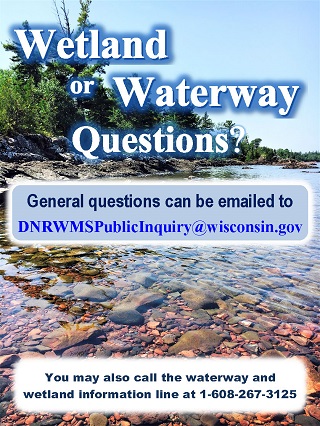Wetland compensatory mitigation
Wetlands provide many functional values, including flood control, water quality, fish and wildlife habitat, and water for rivers and streams. When there are unavoidable adverse impacts on wetlands, it is important to compensate for those impacts with wetland restoration, enhancement, or preservation to ensure that there is no net loss of wetland functions in a watershed over time.
Wisconsin law requires mitigation for wetland impacts approved under wetland individual permits and some projects authorized under the nonfederal wetland exemption. There are three options for satisfying compensatory mitigation requirements.
Wetland Compensatory Mitigation Options
- Wetland Mitigation Banking
A wetland individual permit applicant or exempt project proponent can purchase credits from an approved and open mitigation bank. - In–Lieu Fee Program
A wetland individual permit applicant or exempt project proponent can purchase credits from the DNR Wisconsin Wetland Conservation Trust (WWCT). - Permittee Responsible Mitigation
A wetland individual permit applicant can satisfy their compensatory mitigation requirement by completing a mitigation project in the same watershed service area or within a half-mile of the permitted wetland impact. A nonfederal exempt project proponent can complete a mitigation project within the same compensation search area, which includes the geographic management unit (GMU), the county, and within a 20-mile radius of the impacted wetland.
Wisconsin regulations identify purchasing credits from mitigation banks or the DNR In-Lieu Fee Program as the preferred options to satisfy compensatory mitigation requirements.
See the 2021-22 Biennial Mitigation Report to the Legislature to learn about mitigation trends in Wisconsin.
Nonfederal wetland exemption mitigation basics
In some circumstances, wetland mitigation is required for impacts in exempt nonfederal wetlands. For information regarding nonfederal wetland exemptions and mitigation requirements, see wetland permit exemptions.
Process for projects
- Meeting - For both nonfederal exemptions requiring mitigation and individual permit applicants, applicants should meet with their local wetland specialist before submitting a request to DNR. The purpose of this meeting is to discuss the proposed project purpose and need, the project alternatives to avoid and minimize wetland impacts, the options for wetland mitigation and the information requirements for the application submittal.
- Contact with USACE - Individual permit applicants are also encouraged to contact the appropriate US Army Corps of Engineer project manager to determine whether USACE requires a permit and compensatory mitigation for the intended activity.
- Instruction to satisfy responsibility - After the application has been submitted and the DNR Water Management Specialist has made a preliminary determination of the amount of approvable wetland impact, the DNR Wetland Mitigation Coordinator will notify the applicant of their mitigation requirement after determining which of the available compensatory mitigation options best replaces the wetland functions lost due to the project.
- Individual Permit (IP) Wetland Mitigation Process
- Mitigation Summary Sheet
- Exempt Nonfederal Wetland Mitigation Summary Sheet
Frequently Asked Questions
- What types of DNR regulated wetland activities require compensatory mitigation?
-
Activities that trigger a DNR wetland individual permit will require compensatory mitigation for unavoidable adverse wetland impacts, whereas activities that are regulated under a wetland general permit do not. The U.S. Army Corps of Engineers may also require compensatory mitigation through the Federal Section 404 permitting program and therefore should be contacted early on to determine requirements.
Compensatory mitigation may, therefore, be required as part of a state individual wetland permit, a federal permit or both, making early communication with DNR and USACE a key consideration for applicants. Effective July 1, 2018, some activities in exempt nonfederal wetlands will also require mitigation.
- Is it true that if a wetland individual permit applicant proposes mitigation, they are entitled to receive permit approval?
-
No. Section 281.36(3n), Wis. Stats., reinforces the fact that mitigation does not entitle an applicant to a wetland individual permit. Applicants must first avoid adverse wetland impacts by looking towards the least environmentally damaging practicable alternative and then minimize their effect on wetland functional values, water quality and overall significant adverse environmental consequences.
- Where are bank credits available for purchase and how do I contact them?
-
If DNR and USACE direct you to purchase mitigation bank credits, staff will direct you to specific banks to contact for purchasing credits. The DNR Wetland Mitigation Banks webpage lists all approved and open mitigation banks along with contact information for each bank if you need it.
- Can I buy ILF credits to satisfy my compensatory mitigation requirements?
-
The DNR and USACE will direct you to purchase mitigation bank credits if they are available. If DNR and USACE direct you to purchase ILF credits, DNR will email you with ILF Program contact information. You may also visit the WWCT (In-Lieu Fee Program) website for information regarding credit availability and credit fees.


